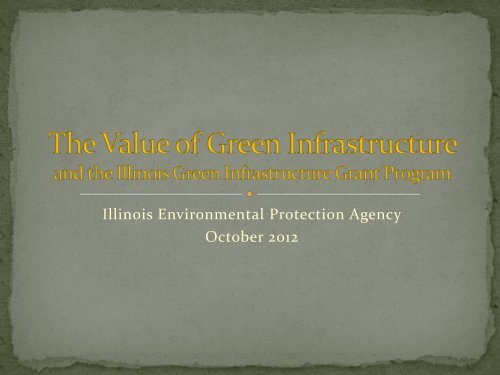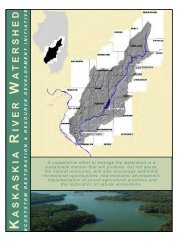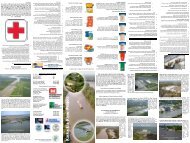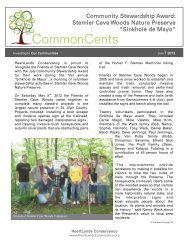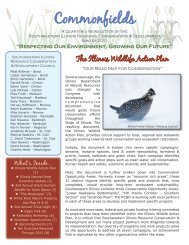Download Presentation - HeartLands Conservancy
Download Presentation - HeartLands Conservancy
Download Presentation - HeartLands Conservancy
You also want an ePaper? Increase the reach of your titles
YUMPU automatically turns print PDFs into web optimized ePapers that Google loves.
Illinois Environmental Protection AgencyOctober 2012
• Is any stormwater management technique or practiceemployed with the primary goal to• preserve• restore• mimic or• enhance natural hydrology• It includes, but is not limited to, methods of using soil andvegetation to• promote soil percolation• evapotranspiration and to• filter, harvest and reuse precipitation
• Reduces flow volume & velocities• Reduces potential for erosion (bank & channel)• Reduces sediment and other pollutants• Reduces fluctuation of lake & stream water levels(high & low)• Improves infiltration and groundwater recharge• Protects and improves wildlife habitat
Reduces:• Combined seweroverflows (#/duration)• Stress on existingwastewater systems• Cost of managementpractices• Flood events (#/size)
• Lowers cost to implement MS4 and Long TermControl Plans (CSO)• Allows for adaptive management• Reduces need for salt/de-icer application• Reduces energy consumption at home, businessand power plant levels• Increases property values
– Decreases solar heat gain– Potential for other food sources– Allows citizen buy in and participation– Improves quality of life and community health(sense of place)
• Clustered housing• Riparian buffers• Reduced width/milesof road way• No curb and gutter• Walking and biking trails• Open space(natural areas and water)
Downspout DisconnectionGuttersDownspoutsSump PumpsRain BarrelsRain Gardens• Captures rain water onsite• Reduces the amount ofwater entering theconveyance systems fortreatment
Green RoofReinforced roof structureAmended soilsPlanting tray (optional)Plants and treesChicago City Hall• Stormwater retention (less insewer system)• Reduced building energy use• Longer roof life• Reduced urban heat islandeffect• Reduced negative healthimpacts from extreme heatevents• Air quality improvements
Green StreetsNarrowed RoadRain Garden Bump OutsCurb Cuts• Captures rain water on-site• Reduces amount of waterconveyed to wastewatertreatment facility• Reduces energy use andemissions• Reduces noise pollution
Permeable Pavement SystemRock baseSand LayerPaver or Porous ConcreteDrain line (optional)• Directly intercepts the rain• Storm water storage• Infiltration of rain water andsnow melt onsite• Reduces noise pollution• Reduces salt use
Planter BoxesPlanter boxesPlants and treesGreen walls• Directly intercepts the rain• Retains water• Contained vegetation
Rain GardenAmended soilsDeep Rooted Vegetation• Intercepts rain fromdownspouts and sump pumps• Increases the soils ability tostore water• Improved plant life
Rain HarvestingCisternGravity or PumpIrrigation• Stormwater retention• Reduces potable water use(irrigation and toilets)• Increases available water supply• Reduces energy use, costs andemissions associated withpotable water conveyance andtreatment• Improves plant health• Public education opportunities
Trees & Urban ForestryTreesPlanter BoxesGreen Walls• Directly intercepts the rain• Increases the soils ability tostore water• Trees reduce the need for airconditioning by reducing windspeeds and providing shade.• Reduces energy consumption
Vegetated SwaleAmended soilsDeep rooted plantsCurb cutsDrain line (optional)• Directly intercepts the rain• Increases the soils ability tostore water• Filters stormwater and allows itto infiltrate into thegroundwater
• Opportunity for ‘treatment trains’ –multiple BMPs that work together(e.g., Bioswale and Porous Pavement Parking Lot)• Operation and Maintenance• Stakeholder ‘Buy In’
Illinois Environmental Protection AgencyOctober 2011
• FY 13 Program Allocation: $5 million• Project Site Focus – CSO drainage area or MS4 area• Eligible entities are those that can legally accept fundsfrom the state of Illinois• Expected Applicants• Municipalities• Sanitary Districts• Park Districts• Watershed Groups and Other Non-Profit Groups
• Grant funds are limited to installation of greeninfrastructure practicesELIGIBLE COSTSAdministration (limited)Design and engineeringConstruction/PlantingConstruction oversightINELIGIBLE COSTSEducation or outreachMonitoringWork done outsidethe grant period• Reimbursement Program• Match is Required
• Projects that implement practices to improve waterquality by reducing or eliminating CSO events• Must be within the drainage area of a CSO• Examples of Eligible Practices• Downspout and Illicit Inflow Disconnections from CSOs• Infiltration Basins/Trenches/Bio-swales• Porous/Permeable Pavements• Not Eligible – Disconnection of Combined Sewer System
• Must be within an MS4 or CSO area• Projects improve water quality in water impaired byurban stormwater runoff• “Programs” (i.e., rain garden cost-share program)• Examples of Eligible Practices• Green Roof/Green Walls/Rain Gardens• Porous/Permeable Pavements• Infiltration Basins/Trenches• Restoration of Riparian/Wetland/Prairie
• Must be within an MS4 or CSO area• Projects improve water quality in waters impaired byurban stormwater runoff• Projects that have high visibility and public access oreducate decision makers will receive greater priority• Examples of Eligible Practices• Green Roof/Green Walls/Rain Gardens• Porous/Permeable Pavements• Infiltration Basins/Trenches• Restoration of Riparian/Wetland/Prairie
CSO Rehabilitation Retention/Infiltration Small Project TotalFY 11 FY 12 FY 11 FY 12 FY 11 FY 12 FY 11 FY 12Applications Received 29 19 75 52 50 16 154 87Applications Funded 6 3 4 2 4 5 14 10Approximate Amount IGIG FundsRequested$18 M $12 M $30 M $21 M $3 M $1M $51 M $34 M
IGIG Projects Vs. Urban Stormwater Impaired Waters
• Quality of Proposal• Feasibility• Anticipated Outputs and Outcomes• Performance and progress measures• Sound plan for measuring progress• Environmental Significance• Financial Integrity• Programmatic Capability & Qualifications of theApplicant• Past History with Illinois EPA
• Financial Assistance Agreement• Product Development• Designs and Engineering• 10 year - Operation and Maintenance Plan Development• BMP Form and Pollutant Load Reduction Calculations• BMP Implementation AFTER Design Approval• Quarterly Reporting• Invoicing• Final Reporting• Reimbursement of Eligible Costs
Christine DavisNonpoint Source UnitIllinois EPA, Bureau of Water217.782.3362christine.davis@illinois.gov


